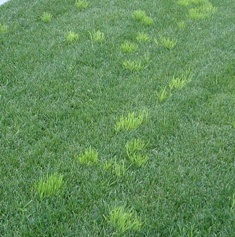Dec
Surviving Winter – Cool Season Turf Diseases
Prepare your Lawn for Winter

Fall is upon us, your home and your lawn is ready for cooler weather, and you’ve followed all our guides to properly overseeding your lawn. So, what’s next on your lawn care list? We’re here to tell you, it’s time to begin winter disease watch! There are numerous varieties of turf diseases that can grab hold of your turf during fall or emerge during winter.
Being able to properly identify these turf diseases will better equip you to fight them off and keep your California and Arizona lawns healthy and green all year long. Take a look at some of these cool-season turf diseases, and remember to stay vigilant this winter.
Cool-Season Turf Diseases
As temperatures begin to cool, air and soil temperatures drop to consistent 65 to 70-degree daytime temperatures, which shifts your turfgrass out of growing and into dormancy. It’s in this transition state that your turfgrass becomes venerable and susceptible to different types of turf diseases such as:
- Leaf Spot – There are leaf spot infections that attack both warm and cool season grasses. If you notice noticeable discoloration in your grass, including gray, tan, red or even purple spots your lawn may be experiencing an infection of leaf spot.
- Pythium Blight – Affects mostly tall fescue and perennial rye grass and is usually caused when the leaf surface is continuously wet. The disease produces brown slimy areas, and white patches. It can spread quickly and kill grass if not treated properly.
- Powdery Mildew – A common cool-season turf disease found in shady areas. The infection resembles white dust. Blades eventually turn tan to brown and if not treated immediately the damage can be permanent.
- Rust – Usually caused from excessive shade, humidity and low mowing. This turf disease is most common in shaded areas during periods of prolonged overcast weather. If you notice your leaves beginning to exhibit rust colored spots, begin spraying a fungicide for rust as soon as symptoms appear.
Cheers to Healthy Turfgrass All Year
While lawn discoloration can be caused by numerous possibilities, from pet urine to heavy foot traffic, it’s important to know what other types of diseases may be hurting your lawn. Once all the common signs of discoloration are ruled out, it’s time to get tough on stopping the spread of other turf diseases.
The best way to protect and fortify your lawn is through proper seasonal care and maintenance. For instance, proper fertilization for both warm and cool-season grasses is what creates a strong lawn that can stand up against disease. However, beware of over-fertilization as this tends to weaken your turf’s root system and causes it to become weaker over time. Remember to follow our seasonal instructions for proper lawn care, and check back on our blog for regularly updated California and Arizona lawn care tips that will help keep your turfgrass green!

